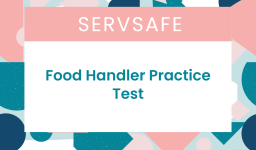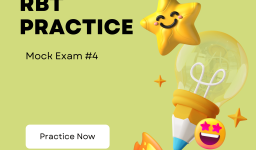Welcome to the RBT 75-Question Practice Exam! This comprehensive practice test is designed to help you prepare for the Registered Behavior Technician (RBT) certification exam.
This exam will assess your knowledge and readiness by covering essential areas such as measurement, assessment, skill acquisition, behavior reduction, documentation and reporting, and professional conduct.
Each question reflects the competencies outlined by the Behavior Analyst Certification Board (BACB).
RBT Mock Exam 2024 Free
Results
Was this helpful?
Don’t Give Up!
While you did not pass the RBT practice exam this time, use this as an opportunity to identify areas for improvement. Review the questions you missed and focus on studying those topics. Consider seeking additional resources or support to strengthen your understanding. Persistence and dedication are key to success, and with continued effort, you will improve and succeed in your next attempt.
Was this helpful?
#1. Which method is most appropriate for measuring the duration of a behavior?
#2. What is the difference between frequency and rate?
#3. Which of the following is an example of indirect assessment?
#4. What does the "A" in an ABC data collection stand for?
#5. What is the primary purpose of a task analysis?
#6. What is the key component of a discrete trial?
#7. Which of the following is an example of a differential reinforcement procedure?
#8. What is the first step in creating a behavior intervention plan (BIP)?
#9. Which of the following is the best practice for documenting sessions?
#10. What should be included in a session note?
#11. How should an RBT respond if asked to perform a task outside of their scope of practice?
#12. Which of the following is an example of maintaining client dignity?
#13. Which recording method involves noting if a behavior occurs at any time during an interval?
#14. What is latency?
#15. What type of assessment involves manipulating variables to determine the function of a behavior?
#16. Which tool is commonly used in indirect assessments to gather information from caregivers?
#17. Which type of reinforcement schedule is best for establishing new behaviors?
#18. What is a prompt hierarchy?
#19. What is extinction?
#20. Which of the following is a function of behavior?
#21. What is the purpose of a progress note?
#22. What should be avoided when writing session notes?
#23. How often should RBTs receive supervision from a BCBA?
#25. Which is an example of naturalistic teaching?
#26. What is the purpose of a preference assessment?
#27. Madelyn observed her client and marks an interval box if the behavior occurs at any point during the interval. Madelyn is using
#28. PLA-CHECK underestimates behavior.
#29. Ed watches his client and marks a box if the behavior of interest is displayed throughout the observed interval. Ed is using
#30. Celeste observes her client and marks whether or not a behavior is occurring at the end of a designated interval. Celeste is using
#31. Which of the following data collection methods provides an overestimate of behavior?
#32. Whole interval recording provides an underestimate of behavior.
#33. Momentary Time Sampling for groups
#34. The most conservative estimate of behavior is provided by the discontinuous data collection method known as
#35. "If a behavior is followed closely in time by a stimulus event and as a result the future frequency of that type of behavior increases in similar conditions" best describes which of the following?
#36. Providing a learner with an iPad following a correct response that results in an increase in correct responses best describes which of the following?
#37. "When a response is followed by the presentation of a stimulus, and, as a result, similar responses occur more frequently in the future" best describes which of the following?
#38. "The occurrence of a response produces the removal, termination, reduction, or postponement of a stimulus, which leads to an increase in the future occurrence of that response" best describes which of the following?
#39. Providing a learner with a break following a correct response that increases correct responses is most likely an example of which of the following?
#40. Money is most likely an example of which of the following?
#41. "A previously neutral stimulus change that has acquired the capability to function as a reinforcer through stimulus-stimulus pairing with one or more unconditioned reinforcers or conditioned reinforcers" best describes which of the following?
#42. Food is an example of which of the following?
#43. "A stimulus change that can increase the future frequency of behavior without prior pairing with any other form of reinforcement" best describes which of the following?
#44. Which one of the following is one of the four basic schedules of reinforcement?
#45. "A reinforcer delivered contingent upon the first behavior following the time period where the time period is fixed" describes which schedule of reinforcement?
#46. Scalloped patterns of responding are typically associated with which schedule of reinforcement?
#47. "A reinforcer delivered contingent upon the first behavior following the time period where the time period is variable" describes which schedule of reinforcement?
#48. Which schedule of reinforcement requires the completion of a specified, unvarying number of responses to produce a reinforcer?
#49. Which schedule of reinforcement requires the completion of a variable number of responses to produce a reinforcer?
#50. Having a learner select which items they like prior to teaching following a systematic protocol to identify hierarchy of potential preferences is known as which of the following?
#51. One problem with informal interviews to identify potential reinforcers is they are not:
#52. Providing free access to a variety of stimuli for the purposes of identifying potential reinforcers is best described by which of the following?
#53. Providing a learner with a series of choices between two items in an effort to identify potential reinforcers best describes which of the following?
#54. Presenting an array of items and asking the learner to select one item and then putting the item back in the array after the selection in an effort to identify potential reinforcers best describes which of the following?
#55. A procedure in which the RBT assesses a variety of variables moment to moment to identify what could potentially function as a reinforcer is known as a(n):
#56. When compared to formal preference assessments, research on in-the-moment reinforcer analysis has shown it to be:
#57. What is a potential problem with using candy as a reinforcer?
#58. Presenting a previously neutral stimulus with an established reinforcer best describes which of the following?
#59. Watching others access stimuli contingent upon a response best describes which of the following?
#60. When using a progressive approach to conditioning reinforcers, one variable the RBT should evaluate is the learner's:
#61. One main difference between bribery and reinforcement is the:
#62. This is the term for when a learner is engaging in disruptive behaviors and is offered something preferred to stop.
#63. When a consequence is provided contingent upon a learner engaging in appropriate behavior and that appropriate behavior is more likely to occur in the future, it is best described by which of the following?
#64. What is one potential problem with bribery?
#65. What is one of the 10 commandments of reinforcement within the Autism Partnership Model?
#66. Which of the following best describes when a learner earns tickets which are eventually exchanged for a toy?
#67. What is one of the most important components of a token economy?
#68. Rainbow tokens most closely align with which schedule of reinforcement?
#69. Which token economy is in place when the learner is unaware of how many tokens are required prior to exchanging?
#70. According to the Leaf and colleagues study, what was the correlation between mock exam scores and the implementation of DTT (Discrete Trial Training)?
Select all that apply:
#73. The practice of objective observation of the phenomena of interest best describes:
#75. _____ is not elicited by preceding stimuli but instead is influenced by stimulus changes that have followed the behavior in the past.
Good luck, and remember, consistent practice and dedication are key to your success!




Leave a comment